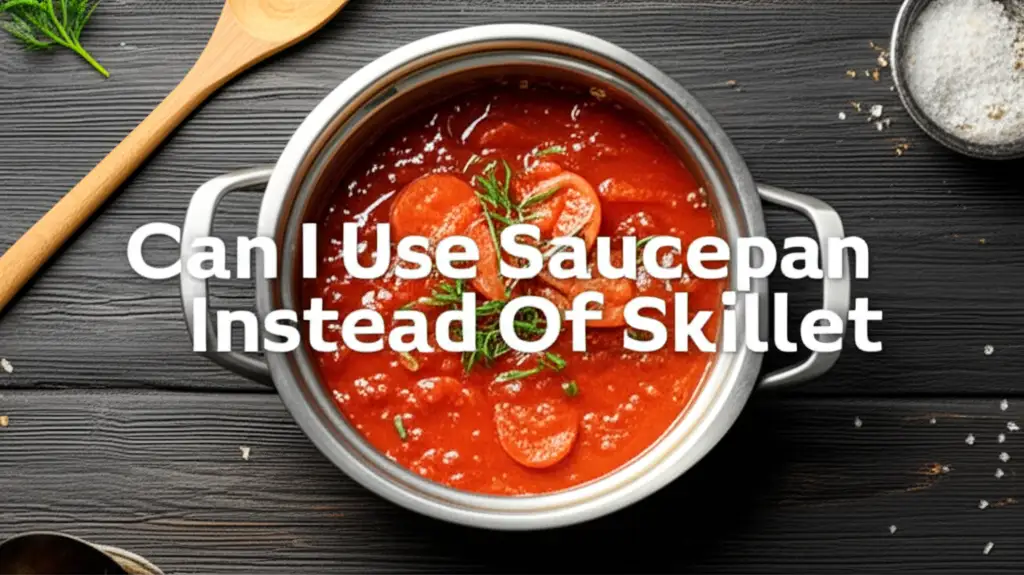· Katria Melrose · Cooking Tips · 16 min read
Can You Make Lemon Curd In Stainless Steel Pan

Making delicious lemon curd at home feels special. Many people wonder about the right pan for this delicate task. My kitchen includes various pots, and stainless steel pans are a staple. They offer a range of benefits for many cooking needs.
Today, we will explore if a stainless steel pan is a good choice for lemon curd. We will cover how to achieve a silky smooth texture. We will also discuss any challenges and how to solve them. By the end, you will feel confident making your own lemon curd.
Takeaway
- Stainless steel pans are excellent for making lemon curd.
- They distribute heat evenly, which prevents scorching.
- Proper technique ensures a smooth, non-stick result.
Yes, you can absolutely make lemon curd in a stainless steel pan. These pans are a great choice due to their even heat distribution and non-reactive nature. With proper heat control and constant stirring, you can achieve a perfectly smooth and delicious lemon curd every time.
Making Lemon Curd in Stainless Steel Pans
Many home cooks wonder about the best pan for lemon curd. I often get asked if a stainless steel pan works well. The answer is a clear yes. Stainless steel is a popular choice for many kitchen tasks. It performs very well when making delicate sauces like lemon curd.
Stainless steel pans conduct heat effectively. This helps prevent hot spots from forming. Hot spots can cause ingredients to cook unevenly or burn. When making lemon curd, you want a gentle, consistent heat. This gentle heat helps the eggs thicken slowly and smoothly.
I find that my stainless steel pans handle the acidity of lemons without issue. Some metals can react with acidic ingredients. This reaction might change the color or taste of your food. Stainless steel does not react this way. It maintains the bright, fresh lemon flavor.
Using a good quality stainless steel pan gives you control. You can see the curd thicken against the light interior. This visual cue helps you know when the curd is ready. Overall, stainless steel offers reliability and safety for your lemon curd creation.
Advantages of Using Stainless Steel for Lemon Curd
Stainless steel pans offer many benefits when making lemon curd. One main advantage is their excellent heat distribution. A pan with a thick, multi-ply base spreads heat evenly across its surface. This even heating prevents the bottom of your curd from scorching. Scorching can ruin the taste and texture of your lemon curd.
Another key benefit is that stainless steel does not react with acidic foods. Lemon juice is highly acidic. Some metals, like aluminum or cast iron (without proper seasoning), can react with acids. This reaction may impart a metallic taste to your food. It can also cause discoloration, turning your bright yellow curd an undesirable shade. Stainless steel remains inert, protecting the pure flavor and vibrant color of your lemon curd.
Stainless steel pans are also very durable. They resist dents, scratches, and warping. This means your pan will last for many years of curd making. Cleaning stainless steel is also straightforward. After cooking, you can easily wash away any residue. For more stubborn messes, learning how to clean stainless steel can be very helpful.
The shiny, smooth surface of stainless steel helps you monitor your curd’s progress. You can easily see if the mixture is thickening correctly. The light color allows you to observe the curd’s beautiful yellow hue. This visual feedback is important for achieving the perfect consistency. I always appreciate how easy it is to keep an eye on my creations in these pans.
Addressing Potential Challenges with Stainless Steel Pans
While stainless steel pans are great, some cooks worry about certain issues. One common concern is sticking. Lemon curd contains eggs, which can stick to pan surfaces. However, with the right approach, sticking is rarely an issue. The key is consistent stirring and low heat.
Another concern is uneven heating. Some thinner stainless steel pans might not distribute heat perfectly. This can lead to some spots cooking faster than others. To avoid this, choose a pan with a heavy, encapsulated base. This design ensures heat spreads uniformly. Uniform heat prevents scorching and promotes smooth thickening.
Acidic foods like lemon juice are non-reactive with stainless steel. This is a significant advantage. Unlike copper or aluminum, stainless steel will not impart a metallic taste. It also will not discolor your vibrant yellow curd. You can trust that your lemon curd will taste pure and bright.
Some people worry about cleaning up sticky residue. Even if some curd clings to the pan, stainless steel cleans up well. You can use warm soapy water and a soft sponge. For tougher spots, a gentle scrub with baking soda and water works wonders. Knowing how to clean stainless steel pan with baking soda can make cleanup even easier. By following these simple steps, you can avoid any common pitfalls.
Essential Tools and Ingredients for Perfect Lemon Curd
Making lemon curd requires a few simple tools and fresh ingredients. Having the right equipment ensures a smooth cooking process. It also helps you achieve the best texture and flavor. Let’s look at what you need to get started.
The Right Pan and Heat Source
You will need a heavy-bottomed stainless steel saucepan. As we discussed, the heavy base provides even heat distribution. This is important for preventing your curd from scorching. A saucepan with a capacity of 1.5 to 2 quarts is usually ideal. It allows enough room for stirring without spills.
A double boiler setup is also highly recommended. While you can cook curd directly in a stainless steel pan, a double boiler offers more gentle heat control. You place your stainless steel pan over a larger pot of simmering water. The steam heats the pan indirectly. This method greatly reduces the risk of overcooking the eggs.
Key Kitchen Tools
- Whisk: A good whisk is essential for constant stirring. It breaks up egg lumps and promotes even thickening. Choose a balloon whisk for best aeration.
- Heat-resistant rubber spatula: This tool helps scrape down the sides and bottom of the pan. It ensures all parts of the curd cook evenly.
- Fine-mesh sieve: Straining the curd through a sieve is crucial. It removes any small bits of cooked egg or lemon zest. This step guarantees a silky smooth texture.
- Measuring cups and spoons: Accuracy is important in baking and curd making. Precisely measure all ingredients for consistent results.
- Grater or zester: For fresh lemon zest. A microplane zester works best to get fine zest.
Fresh, Quality Ingredients
- Lemons: Use fresh, organic lemons if possible. You need both the juice and the zest. The zest holds much of the lemon’s essential oil and flavor.
- Eggs: Large eggs are standard. You will typically use whole eggs and sometimes extra egg yolks for richness. Ensure your eggs are fresh.
- Granulated sugar: Sugar balances the tartness of the lemon. It also helps create the curd’s smooth consistency.
- Unsalted butter: Cold, unsalted butter adds richness and shine. It also helps the curd thicken and set as it cools. Cut it into small cubes for quicker melting.
- Pinch of salt: A tiny bit of salt enhances all the flavors. It makes the lemon taste brighter.
Gathering these items before you start makes the curd-making process much smoother. I always lay everything out on my counter first. This way, I do not search for items while cooking. This preparation helps ensure success.
Step-by-Step Guide: Making Lemon Curd in Your Stainless Steel Pan
Making lemon curd is a rewarding process. Following these steps ensures a perfect batch every time. This method focuses on using your stainless steel pan effectively.
Step 1: Prepare Your Ingredients and Pan
First, gather all your ingredients. Zest your lemons before juicing them. You can get more zest this way. Measure out your sugar, lemon juice, and eggs. Cut your cold butter into small cubes. This helps it melt faster later.
Set up your stainless steel saucepan. If using a double boiler, fill a larger pot with an inch or two of water. Place your stainless steel pan on top. Make sure the bottom of the stainless steel pan does not touch the water. The steam will cook the curd.
Step 2: Combine Wet Ingredients
In your stainless steel pan (or top of the double boiler), whisk together the lemon zest, lemon juice, sugar, and whole eggs. If your recipe includes extra egg yolks, add them now too. Whisk until the mixture is uniform and the sugar starts to dissolve.
Step 3: Cook the Curd Gently
Place the pan over low to medium-low heat. If using a double boiler, bring the water in the bottom pot to a gentle simmer. Begin stirring the curd mixture constantly with a whisk or a heat-resistant rubber spatula. Do not stop stirring. Consistent stirring prevents the eggs from scrambling. It also prevents the curd from sticking to the bottom of the pan.
Continue cooking and stirring. The mixture will slowly thicken. This process usually takes 10 to 15 minutes. Pay close attention to the curd’s texture. It should coat the back of a spoon. When you draw a line with your finger on the spoon, the line should hold its shape. The temperature should reach about 170°F (77°C) if you use a thermometer.
Step 4: Incorporate Butter and Strain
Once the curd is thick, remove the pan from the heat. Immediately add the cold butter cubes, one at a time. Whisk each piece in until fully melted and incorporated. The butter adds richness and shine. It also helps the curd set properly.
Next, pour the hot curd through a fine-mesh sieve into a clean bowl. This step is crucial for a silky smooth texture. It catches any bits of cooked egg or zest. Press the curd through the sieve using your spatula.
Step 5: Cool and Store
Place a piece of plastic wrap directly onto the surface of the warm curd. This prevents a skin from forming as it cools. Let the curd cool at room temperature for a while. Then, refrigerate it until it is fully chilled and set. This takes at least 2-3 hours. Once chilled, your homemade lemon curd is ready to enjoy.
By following these steps, you will create a vibrant, smooth lemon curd. Your stainless steel pan will handle the cooking beautifully. Remember, patience and constant stirring are your best friends here.
Tips for Achieving a Smooth, Silky Lemon Curd Texture
Achieving a perfectly smooth, silky lemon curd texture is the goal. A few key techniques make all the difference. I have learned these tips over many batches of curd. They help avoid a lumpy or grainy result.
1. Consistent, Gentle Heat
Heat control is paramount. Never rush the cooking process. Cook the curd over low to medium-low heat. This gentle heat allows the egg proteins to thicken slowly. High heat will cause the eggs to cook too fast. They will scramble, creating lumps. If you see steam, your heat is likely too high. A double boiler offers the best gentle heat. It warms the curd indirectly, preventing scorching.
2. Constant Stirring
Stirring is non-negotiable. Use a whisk or a heat-resistant rubber spatula. Stir continuously, scraping the bottom and sides of your stainless steel pan. This action prevents the eggs from sticking and cooking unevenly. It also helps create a smooth, homogenous mixture. Think of it as a meditation – rhythmic stirring leads to perfect curd.
3. Strain for Smoothness
Even with careful cooking, tiny bits of cooked egg or lemon zest can remain. Straining the curd through a fine-mesh sieve is essential. Do this immediately after cooking and adding the butter. It ensures a truly silky texture. Do not skip this step. It makes a significant difference in the final product.
4. Correct Consistency Check
Knowing when the curd is ready is important. The curd should thicken enough to coat the back of a spoon. When you run your finger across the spoon, the line should hold its shape. It should not fill back in. This “nappe” stage indicates the curd has reached its ideal thickness. Overcooking will lead to a very thick, almost gummy curd. It can also cause the eggs to curdle.
5. Add Butter Cold
Adding cold butter cubes at the end is a crucial step. The cold butter helps to cool down the hot curd quickly. This stops the cooking process and prevents overcooking. Whisk it in one piece at a time. The butter also adds richness, gloss, and helps set the curd. It contributes to that desirable silky mouthfeel. Following these tips ensures your lemon curd is always delightfully smooth.
Storing and Enjoying Your Homemade Lemon Curd
Once you have made a perfect batch of lemon curd, proper storage is key. This ensures it stays fresh and delicious for as long as possible. Lemon curd is versatile. You can enjoy it in many ways.
Proper Storage
After straining the curd, transfer it to clean, airtight jars. Make sure the jars are sterilized first. Place a piece of plastic wrap directly on the surface of the curd. This prevents a skin from forming as it cools. Let the curd cool completely at room temperature. Then, refrigerate it.
Lemon curd lasts well in the refrigerator. It usually stays fresh for up to two weeks. Always check for any signs of spoilage before eating. These signs include an unusual smell, mold, or discoloration. Freezing lemon curd is also an option. It can be frozen for up to two months. Thaw it slowly in the refrigerator before use. The texture might change slightly after freezing, but it remains delicious.
Creative Ways to Enjoy Lemon Curd
Lemon curd is incredibly versatile. Its bright, tangy flavor adds a wonderful zing to many dishes. Here are some of my favorite ways to enjoy it:
- Classic Spreads: Spread it on toast, scones, or English muffins for a simple, elegant breakfast or tea-time treat.
- Dessert Topping: Use it as a topping for pancakes, waffles, or crepes. It adds a gourmet touch to breakfast.
- Baking Ingredient:
- Tarts and Pies: Lemon curd is the star in classic lemon meringue pie or simple lemon tarts.
- Cakes and Cupcakes: Use it as a filling between cake layers. You can also pipe it into cupcakes.
- Cookies: Fill thumbprint cookies with a dollop of curd.
- Yogurt or Ice Cream: Stir a spoonful into plain yogurt for a tangy snack. Or drizzle it over vanilla ice cream for a refreshing dessert.
- Parfaits: Layer lemon curd with whipped cream, berries, and crumbled cookies. This creates a beautiful and delicious parfait.
My personal favorite is a simple spoonful eaten directly from the jar. The vibrant taste is incredibly satisfying. With proper storage, you can enjoy your homemade lemon curd in many delightful ways. It brings a touch of sunshine to any meal or dessert.
Maintaining Your Stainless Steel Pan After Making Lemon Curd
Cleaning your stainless steel pan after making lemon curd is important. Proper care ensures its longevity and performance. Stainless steel is durable, but it still benefits from good cleaning habits.
After you empty the lemon curd, fill the pan with warm water. Add a drop of dish soap. Let it soak for a few minutes. This helps loosen any lingering curd residue. Soaking prevents dried-on food from becoming hard to remove.
Use a soft sponge or cloth to wash the pan. Avoid abrasive scrubbers or steel wool. These can scratch the pan’s surface. Wash thoroughly with warm, soapy water. Rinse the pan completely to remove all soap.
For any stubborn spots or slight discoloration from cooking, a paste of baking soda and water works well. Apply the paste to the affected area. Let it sit for a few minutes. Then, gently scrub with a soft cloth. Rinse well. This method is effective for minor stains. I often use this trick to keep my pans sparkling clean. You can learn more about how to clean stainless steel pan with baking soda for detailed steps.
Ensure your pan is completely dry before storing it. Water spots can form if pans air dry, especially with hard water. You can wipe it dry with a clean dishtowel. This keeps the pan looking its best.
Some people prefer to put their stainless steel pans in the dishwasher. Most stainless steel pans are dishwasher safe. However, hand washing is often gentler. It helps maintain the pan’s finish over time. If you decide to use a dishwasher, always check the manufacturer’s instructions. You can find more information about can I put my stainless steel pan in the dishwasher to guide you.
Regular and gentle cleaning keeps your stainless steel pan in excellent condition. It will be ready for your next batch of lemon curd. A well-maintained pan also cooks better and more evenly. Taking care of your cookware saves you effort in the long run.
Frequently Asked Questions About Making Lemon Curd
Q1: Can I use fresh or bottled lemon juice for lemon curd?
A1: Fresh lemon juice is always best for lemon curd. It provides the brightest, most vibrant flavor. Bottled lemon juice can have a duller taste. It may also contain preservatives that affect the texture. For the best result, use freshly squeezed lemon juice.
Q2: Why did my lemon curd turn out lumpy?
A2: Lumpy lemon curd often happens due to high heat or insufficient stirring. Eggs cook quickly when exposed to too much heat. This causes them to curdle. Constant, gentle stirring breaks up any forming lumps. It also ensures even cooking throughout the mixture.
Q3: How do I know when my lemon curd is thick enough?
A3: Lemon curd is thick enough when it coats the back of a spoon. If you draw a line across the spoon coating with your finger, the line should hold its shape. It should not run back together. This stage indicates the curd has reached its optimal consistency.
Q4: Can I make lemon curd without a double boiler?
A4: Yes, you can make lemon curd directly in a stainless steel pan. Use very low heat and stir constantly. A double boiler offers more gentle, indirect heat. This reduces the risk of scorching or scrambling the eggs. If cooking directly, pay close attention to the heat.
Q5: What if my lemon curd is too tart or too sweet?
A5: The tartness or sweetness of lemon curd depends on the lemons and your preference. If it’s too tart, you can add a tiny bit more sugar while it’s warm. If it’s too sweet, adding a splash of fresh lemon juice can help. Adjustments are best made before the curd fully cools.
Q6: How long does homemade lemon curd last?
A6: Homemade lemon curd stored in an airtight container in the refrigerator lasts about two weeks. For longer storage, you can freeze lemon curd for up to two months. Always check for any signs of spoilage before consuming.
Conclusion
Making lemon curd in a stainless steel pan is not only possible but also a fantastic choice. We have explored the many benefits of using these pans. Their ability to distribute heat evenly prevents scorching. Their non-reactive nature keeps your lemon curd bright and flavorful. With the right techniques, you can achieve a wonderfully smooth, silky texture every time.
From selecting the best ingredients to mastering the gentle stirring process, each step contributes to a perfect result. Remember the importance of constant attention during cooking and straining for that ideal consistency. Caring for your stainless steel pan after use ensures it will serve you well for many batches of delicious lemon curd. Now, gather your ingredients and confidently whip up a batch of homemade lemon curd. Your taste buds will thank you!





